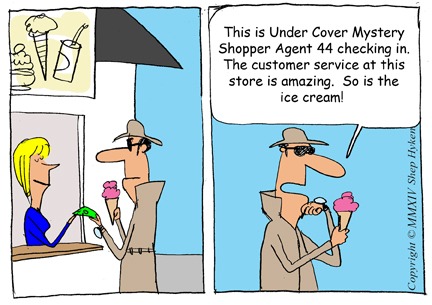 Customer Service Best Practices
Customer Service Best Practices
I just returned from speaking at the International Franchise Association convention. This was my sixth year speaking at this great organization’s conference and I decided it should be more of a conversation than a speech. While there was plenty of content in the session, I asked our audience members to share their best practices that related to the various topics that were in the presentation.
One of these best practices came from Jim Brown, the Chief Operating Officer of Handels, a chain of homemade ice cream and yogurt shops. By the way, you should know that this chain of ice cream shops has numerous accolades including listed as being number one in the world for ice cream according to the book, “The Ten Best of Everything: The Ultimate Guide to Travel” published by National Geographic.
His best practice had to do with complaints. My first response to Jim, after he told me about Handels, was how many complaints does an ice cream store typically receive? Probably not many, but when Jim does receive a complaint from a customer, the first thing he does is what most of us do. He apologizes to the customer and discusses what he can do to make the situation right. So far, that’s nothing special at all. But then he does something interesting, if not somewhat unique. He invites this complaining customer to be part of his secret shopper program. He actually turns his complainers into mystery shoppers!
What a brilliant idea. He not only apologizes and fixes the problem. He enlists their help to ensure a positive experience for other customers. And, the customers love doing this. Sure, they get some free ice cream for helping, but they also get to feel like part of the Handel’s team. He turns these complaining customers into customer evangelists!
This idea is so simplistic, but the results are excellent. Most of the time when there is a complaint, we want to resolve it and restore the customer’s confidence in doing business with us. This takes it one step further. This almost guarantees that the customer will not only come back, but become loyal as a result of the “bond” that develops when the customer becomes part of the team.
I’m constantly amazed at how many different ideas people and companies use to amaze their customers. What ideas do you have that turns complainers into evangelists? Send me an email and I may just include it in my next book.




This is fine as far as it goes; but, what about complaints that are never expressed? Very few complaints by b2c customers are ever expressed, giving the company no opportunity to reclaim customer trust: http://customerthink.com/customer_complaints_learn_the_real_value_of_getting_the_whole_picture/
Hi Michael – I agree with you, but when customers do complain, that is what this article is about. Handel’s way of responding to these complaints is interesting. What about the customers whose complaints aren’t expressed? Well, that’s a great topic for another article.
As always, appreciate your comments.
I’ve always used the ‘iceberg in a reservoir’ analogy with complaints – an organization can see only about 5% of the complaints. The rest are hidden and usually not expressed. Apologizing for poor experiences is great – if the company knows about the issue. If they don’t – and in b2c companies that occurs about 90% to 95% of the time – the most customer-centric organizations have a mechanism for surfacing these hidden issues. And, these companies also excel by including employees in the debriefing prochttp://customerthink.com/linking_employee_behavior_to_customer_loyalty_advocacy/ess.
I’d suggest that, like Starbucks and Nordstroms, Handels is customer-friiendly rather than customer-centric.
All the stats and facts prove your iceberg theory is correct. There are programs that companies have in place to solicit feedback. I was reading through one of your articles where you quote a friend of mine, Janelle Barlow. She says, “A complaint is a gift!” So, when you are fortunate to have a customer complain, take advantage of it. The Handels example in the article is an excellent example of how to do so.
Janelle Barlow clearly has it right. Repeated studies show that under 10% of b2c customers and under 40% of b2b customers contact suppliers with complaints or problem issues, giving the organization little opportunity to recover and rectify.. These same studies, however, show that high percentages of customers do have complaints; but, for a variety of reasons, they will go unregistered. Even the best of ‘customer friendly’ companies, like Handels (and Starbucks and Nordstroms) would be well advised to proactively solicit complaints from a representative sampling of customers, and on a routine basis, if only to stay current on what negative issues may undermine loyalty behavior. Then, the analytical discipline would be to identify, on a prioritized basis, which performance elements are most contributing to customer risk and churn.